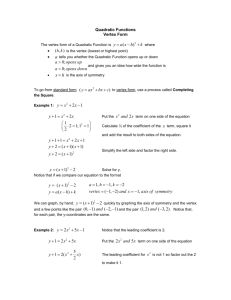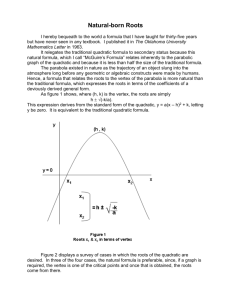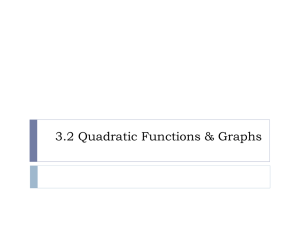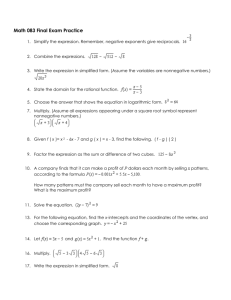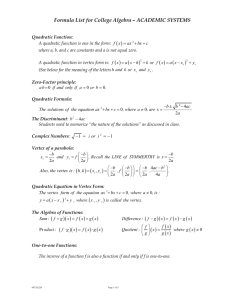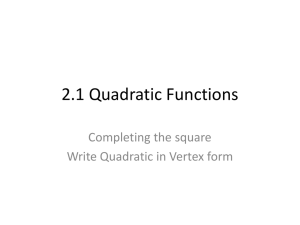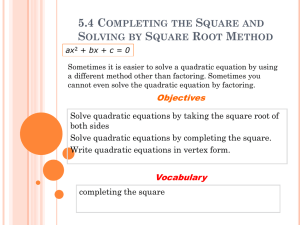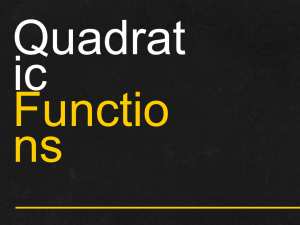Finding the Vertex of a Quadratic Function
advertisement
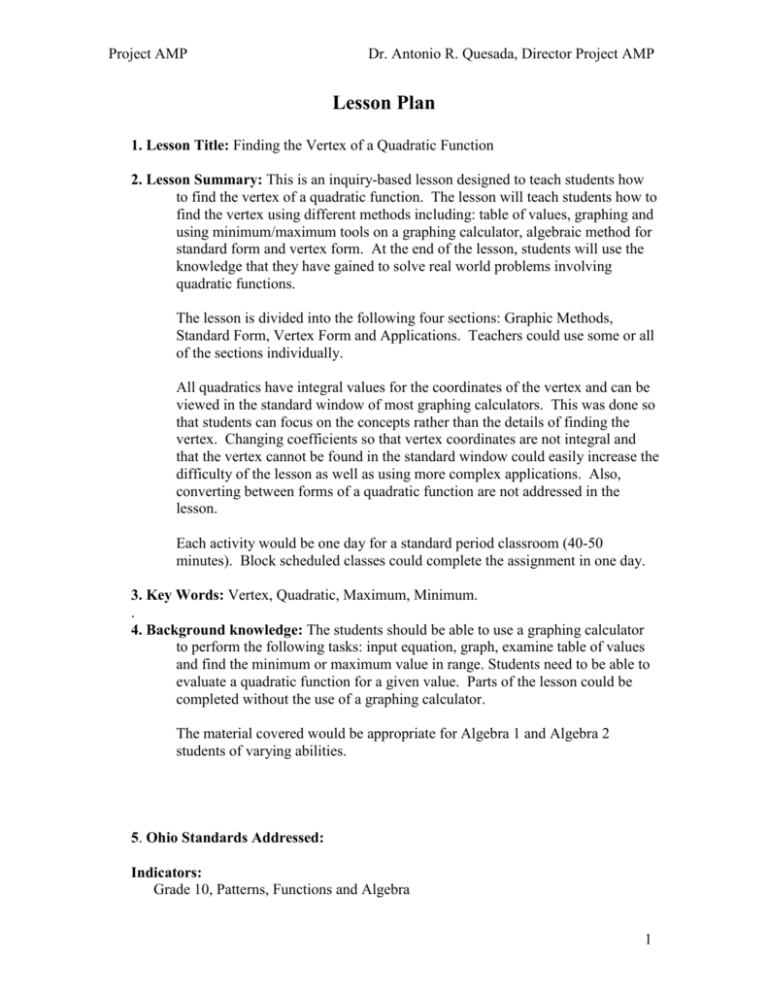
Project AMP Dr. Antonio R. Quesada, Director Project AMP Lesson Plan 1. Lesson Title: Finding the Vertex of a Quadratic Function 2. Lesson Summary: This is an inquiry-based lesson designed to teach students how to find the vertex of a quadratic function. The lesson will teach students how to find the vertex using different methods including: table of values, graphing and using minimum/maximum tools on a graphing calculator, algebraic method for standard form and vertex form. At the end of the lesson, students will use the knowledge that they have gained to solve real world problems involving quadratic functions. The lesson is divided into the following four sections: Graphic Methods, Standard Form, Vertex Form and Applications. Teachers could use some or all of the sections individually. All quadratics have integral values for the coordinates of the vertex and can be viewed in the standard window of most graphing calculators. This was done so that students can focus on the concepts rather than the details of finding the vertex. Changing coefficients so that vertex coordinates are not integral and that the vertex cannot be found in the standard window could easily increase the difficulty of the lesson as well as using more complex applications. Also, converting between forms of a quadratic function are not addressed in the lesson. Each activity would be one day for a standard period classroom (40-50 minutes). Block scheduled classes could complete the assignment in one day. 3. Key Words: Vertex, Quadratic, Maximum, Minimum. . 4. Background knowledge: The students should be able to use a graphing calculator to perform the following tasks: input equation, graph, examine table of values and find the minimum or maximum value in range. Students need to be able to evaluate a quadratic function for a given value. Parts of the lesson could be completed without the use of a graphing calculator. The material covered would be appropriate for Algebra 1 and Algebra 2 students of varying abilities. 5. Ohio Standards Addressed: Indicators: Grade 10, Patterns, Functions and Algebra 1 Project AMP Dr. Antonio R. Quesada, Director Project AMP 10. Solve real-world problems that can be modeled using linear, quadratic, exponential, or square root functions. Grade 11, Patterns, Functions and Algebra 3. Describe and compare the characteristics of the following families of functions: quadratics with complex roots, polynomials of any degree, logarithms, and rational functions. 4. Identify the maximum and minimum points of polynomial, rational and trigonometric functions, graphically and with technology. Benchmarks: Grade 10: D: Use algebraic representations, such as tables, graphs, expressions, functions, and inequalities to model and solve problem situations. Grade 11: A: Analyze functions by investigating rates of change, intercepts, zeroes, asymptotes, and local and global behavior. 6. Learning Objectives: Students will understand the concept that the vertex is either the minimum or maximum value of a quadratic function. Students will be able to find the vertex of a quadratic using a variety of methods including: table of values, graphing and using minimum/maximum tools on a graphing calculator, algebraic method for standard form and vertex form. Student will be able to apply this knowledge to solve real world problems involving quadratic functions. 7. Materials: Graphing calculator. This was written for use with a TI-83 or TI-84. Some directions would need to be modified for other graphing calculators. 8. Suggested procedures: a. The instructor can choose an “attention getter” of his/her choice. Some examples could be “How do you find the maximum height of bottle rocket?” “How do you find the maximum height of Lebron James when he is dunking a basketball?” Also, any other question involving projectile motion that would interest your specific groups of students could be used. b. Students could work individually or they could be grouped in any manner that the instructor sees fit to use. It is suggested that students work cooperatively and then review the lesson as a larger group. 9. Assessment(s): A variety of assessments could be used to evaluate students’ knowledge of the material. It is suggested that both formative and summative assessments are implemented. Each section has a problem that allows students to test their conjectures and/or findings. These could be used as formative assessments. In terms of summative 2 Project AMP Dr. Antonio R. Quesada, Director Project AMP assessments, this lesson in and of itself would probably be best included in a larger assessment. Finding the Vertex of a Quadratic Function Investigation Goals: Students will be able to find the vertex of a quadratic function using a variety of methods. Students will be able to use these methods to solve real world problems. Activity 1. Graphic Methods 1. Graph the following functions on your graphing calculator. Sketch the graph below. Every quadratic function will have either a maximum or minimum value. Determine whether each function has a maximum or minimum value. f(x) = x2 – 3 g(x) = 2x2 – 4x h(x) = -3x2 – 12x + 1 k(x) = - x2 + 8x - 16 2. Make a conjecture about how you could determine whether a quadratic function has either maximum or minimum value WITHOUT graphing: 3 Project AMP Dr. Antonio R. Quesada, Director Project AMP 3. Determine if the following functions have either maximum or minimum values. Then check your answer by graphing. Include a sketch of your graph. (You do not need to find the actual value of the max/min) a(x) = -2x2 – 3x - 2 b(x) = 5x2 – 4x – 9 c(x) = -x2 + 2x + 1 j(x) = x2 + 8x - 10 4. Was your conjecture correct? If not, what would be a more accurate conjecture? Define Vertex: The vertex of a quadratic function can be defined in many ways. For our purposes right now, we will define the vertex as the maximum or minimum point of the graph of the quadratic. 5. Find the vertex of each of the following functions by graphing the function on your graphing calculator. (Remember: Go to 2nd-calc-minimum/maximum. Now you must select a value to the left and right of the vertex. Then hit Enter until the calculator gives you the value at the vertex.) (For TI-Nspire use the point on utility). Include a sketch of the graph. r(x) = -2x2 – 4x - 2 s(x) = 4x2 + 8x - 6 4 Project AMP Dr. Antonio R. Quesada, Director Project AMP t(x) = x2 – 10x + 22 w(x) = -3x2 – 12x – 7 6. Now for each of the functions in number 5, complete the table of values below. Include the x-value at the vertex (place this in the box marked V) and the next three x-values greater than and less than the x-value at the vertex. r(x) = -2x2 – 4x – 2 x y s(x) = 4x2 + 8x - 6 V x y V t(x) = x2 – 10x + 22 x y w(x) = -3x2 – 12x – 7 V 5 Project AMP Dr. Antonio R. Quesada, Director Project AMP x y V 7. What do you notice about the table of values? (Hint: think symmetry) 8. Make a conjecture about how you could determine the vertex of a quadratic function based on a table of values: 9. From the table of values below, determine the vertex of each quadratic function. Decide if it is a maximum or a minimum. Also connect this to your conjecture in question #4 and determine the sign of the coefficient of the x2 term. x -2 -1 0 1 2 3 y 8 3 0 -1 0 3 6 Project AMP x 1 2 3 4 5 6 y -4 1 4 5 4 1 x y -2 27 -1 12 Dr. Antonio R. Quesada, Director Project AMP 0 3 1 0 2 3 3 12 x -11 -10 -9 -8 -7 -6 y -14 -9 -6 -5 -6 -9 10. Was your conjecture correct? If not, what would be a more accurate conjecture? 11. Review and Compare: For each function below find the vertex using both methods that we have discussed so far: A. Graph and use max/min function on your calculator. Sketch the graph. B. Graph and examine table of values. Show at least five table values. q(x) = x2 – 6x + 4 p(x) = -2x2 - 8x - 6 m(x) = -x2 + 10x - 15 n(x) = 3x2 – 12x +3 7 Project AMP Dr. Antonio R. Quesada, Director Project AMP Activity 2. Algebraic Methods – Standard Form Definition of Standard form of a quadratic function: The standard form of a quadratic function is when the quadratic is written as f(x) = ax2 + bx + c 12. Place each of the following functions in standard form and identify the values for a, b and c. (these are the same functions that we evaluated in Activity 1, Number 5 just in a different format) r(x) = -2 - 2x2 – 4x s(x) = 4x2 + 6x – 6 + 2x t(x) = x2 + 22 – 10x w(x) = -2x2 – 22x – 7 – x2 + 10x 13. Find the value of negative b divided by 2 times a (–b/2a) for each of the functions in number 12. r(x) = s(x) = 8 Project AMP Dr. Antonio R. Quesada, Director Project AMP t(x) = w(x) = 14. What do you notice about the x-values you found in the vertices of the functions in #5 and the values of –b/2a in number 13? 15. Take the value of –b/2a that you found for each function in #13 and plug that back into the original function for x and evaluate the function. r(x) = s(x) = t(x) = w(x) = 16. What do you notice about the y-values you found in the vertices of the functions in #5 and the values you found in #15? 9 Project AMP Dr. Antonio R. Quesada, Director Project AMP 17. Make a conjecture about the relationship between the vertex of a quadratic function and the values of a, b and c in the standard form of a quadratic equation. 18. Write a step by step algebraic process (algorithm) that someone could use to find the vertex of a quadratic function that is in standard form. 19. Use the algorithm that you have created in #18 to find the vertex of each of the following quadratic functions. Verify your answers by using one of the graphing methods you used in Activity 1. Show your work below. f(x) = 4x2 + 8x – 3 g(x) = ½ x2 + 8x +25 h(x) = -4x2 + 24x – 31 i(x) = -x2 - 5 1 0 Project AMP Dr. Antonio R. Quesada, Director Project AMP 20. Was your algorithm from #18 correct? If not, what would be a more accurate algorithm? Activity 3. Algebraic Methods – Vertex Form Definition of Vertex form of a quadratic function: The vertex form of a quadratic function is when the quadratic is written as f(x) = a(x-h)2 + k 21. Each of the following functions are in vertex form. Identify the values for a, h and k. (these are the same functions that we evaluated in Activity 1, Number 5 just written in a different form) (Hint: the formula is –h not h, so remember to take the opposite of what you see in the function.) r(x) = -2(x+1)2 s(x) = 4(x+1)2 - 10 t(x) = (x-5)2 – 3 w(x) = -3(x + 2)2 + 5 1 1 Project AMP Dr. Antonio R. Quesada, Director Project AMP 22. What do you notice about the x-values you found in the vertices of the functions in #5 and the values of h in #21? 23. What do you notice about the y-values you found in the vertices of the functions in #5 and the values of k in #21? 24. Make a conjecture about the relationship between the vertex of a quadratic function and the values of a, h and k in the vertex form of a quadratic equation. 25. Write a step by step algebraic process that someone could use to find the vertex of a quadratic function that is written in vertex form. 1 2 Project AMP Dr. Antonio R. Quesada, Director Project AMP 26. Use the algorithm that you have created to find the vertex of each of the following quadratic functions. Verify your answers by using one of the graphing methods you used in Activity 1. f(x) = -2(x-6)2 + 8 g(x) = (x+2)2 - 3 q(x) = 2(x – 3)2 p(x) = -3(x + 5)2 -1 27. Was your conjecture correct? If not, what would be a more accurate conjecture? 1 3 Project AMP Dr. Antonio R. Quesada, Director Project AMP Activity 4. Applications 28. An object thrown into the air is modeled by the equation: h(t) = -4.9t2 + vot + ho where vo is the initial velocity, ho is the initial height above the ground and (t) is the height after t seconds. A person throws a ball with an initial upward velocity of 12 m/sec. The ball is released when it is 1.8 meters from the ground. A. Find the equation that would give the height of the ball t seconds later. B. After how many seconds will the ball reach its peak (i.e. maximum height)? What will the maximum height be? Use at least two methods. Show your work below. 29. Kevin wants to fence in his backyard using a rectangular region so that his dogs can have a safe play area. He has purchased 140 feet of fencing. To help the fencing cover a greater square area, Kevin will use the back of his house as one side of the enclosed yard. A. Find the equation that would give the area of the rectangular region that Kevin fenced in. Include a drawing to show how you determined the equation. 1 4 Project AMP Dr. Antonio R. Quesada, Director Project AMP B. Find the maximum area that can be enclosed. Find the dimensions that produce the maximum area. Use at least two methods. Show your work below. 30. Quad Hardware Company produces c-clamps. The production cost will go down the more units the company produces. However, you also know that production costs will eventually go up if you make too many c-clamps, due to storage requirements and overtime pay. The equation to produce x thousands of c-clamps a day can be approximated by the following formula: C = 0.08x2 – 8.5x + 2600 cost is in thousands of dollars. A. Find the daily production level of c-clamps that will minimize production costs for Quad Hardware. B. Find the minimum production cost. 1 5 Project AMP Dr. Antonio R. Quesada, Director Project AMP 1 6


